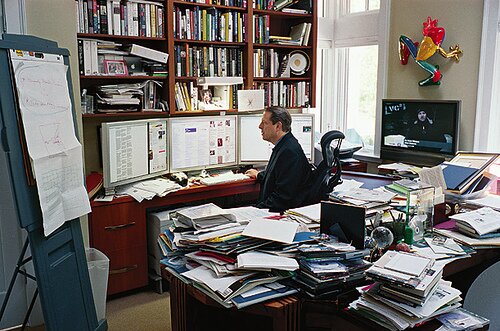A few years ago, Mary Czerwinski, a researcher at Microsoft Research Labs, demonstrated that increasing the amount of real estate on a computer screen dramatically improved productivity. She found that the clearer your screen, the calmer your mind. Czerwinski’s experiments utilized a 42-inch (!) screen, but anyone who has hooked up two or three monitors to their computer understands the value of the added screen space. Switching from one task to another is far easier when you don’t have to toggle between programs (and windows) to find what you need.
That’s what makes this picture of Al Gore’s office so peculiar.  Clearly, Al gets the idea that multiple monitors enhance productivity. But look at the rest of the office. It’s a disaster. I’m willing to bet that (1) he doesn’t know what half of the stuff he has piled up is; and (2) at least half of it is obsolete or low-value junk.
Clearly, Al gets the idea that multiple monitors enhance productivity. But look at the rest of the office. It’s a disaster. I’m willing to bet that (1) he doesn’t know what half of the stuff he has piled up is; and (2) at least half of it is obsolete or low-value junk.
How long would it take him to disinter a piece of valuable information from that mess? What ideas languish stillborn in his office because he wasn’t aware of – or forgot about – their existence? (I realize that my approach flies in the face of the argument presented in “A Perfect Mess: The Hidden Benefits of Disorder.” See my earlier blog post about that book here.)
Think about it: if productivity on the computer is enhanced by having a clearer electronic space, shouldn’t the same hold true of your physical space?
